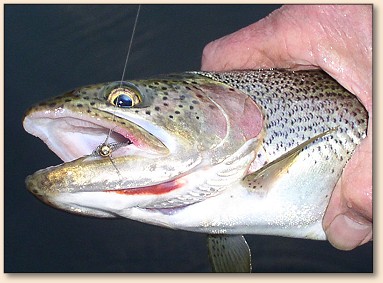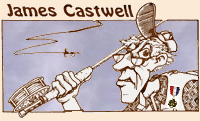|
As most flyfishers soon learn the Adams fly was 'born' near Traverse
City, Michigan many years ago. It was named for an attorney named
Adams. It was used first on the Boardman river there to catch trout
while some caddis were emerging. It, however looks very much like a
may fly and that has been it's downfall all these years.
Someone who still eludes history seemed to think that the substitution
of hackle tip fibers for the tail would me an improvement. Make it
float much better. Logical, but wrong. The fly seemed to work very
well as designed and indeed reached fame in that condition. Why it
could not have been left well enough alone I do not know.
The rather skinny, non-tapered body was improved over the years to
become a nicely fat thoraxed, fully tapered body comprised of
anything somewhat gray that might float. In fact, the better it
floated the better. Again, logical, but wrong. The original did
quite well, thank you, as it was. Why change it? And how much
can one change a fly and still call it by it's native name?
So now, the Adams fly is a nicely tapered bodied, hackle tip tailed,
grizzlyish hackled, high floating mayfly type of dry fly. How sad that
the great fly of yesteryear has been lost to civilized society and the
great urge of most to improve things which should not be. As the Adams
was a rather poorly floating, skinny bodied, improvised tailed,
uncertain hackled imitation of a caddis about to become air-born
I think any of its kin should reflect the original not the
questionable offspring of unknown parenting.
If a tyro should equip himself with a copy of the original Adams
he would be well served to tempt trouts when there were caddis
about. That the fly does not well represent a mayfly is of no
concern for this discussion. If the tyro should like a fly that
precedes the Adams in its development as an insect then the
beadhead Adams is the fly for his consideration. It will however,
be tied with the real Adams materials or it should not be correctly
given the appellation of Beadhead Adams.
Therefore it shall consist of a Golden Pheasant tippet tail, a
straight wool body, one each of a brown and a grizzly (barred rock)
hackle feathers and of course, the bead head. This fly will allow
the fisher greater flexibility and range of opportunity in fly
fishing situations where form and presentation are of valued
consideration. This is a venture into the depths of fly-fishing
history itself and will be hailed by all as a natural extension
of the original concept with us all these years.
That I was born also in Traverse City, Michigan and did my first
fishing for brookies on a tributary of the Boardman is of some
interest and grants more than a bit of 'license' to this newest
of fly families. The Bead-head Adams was also introduced for the
first time as the Michigan Fish-In at Gates Au Sable Lodge, July 2007.
That there are those who will lay claim to flies of similar style is
of no concern either, there are always those detractors who scoff at
true investigative research and development. They are ignored. This
is a truly new form of fly, a separate section of the arts, a
fulfilling of a void in our pastime, a necessary addition to a
great fly. The Adams. I present to you the 'Beadhead Adams.' (For more
information and tying instructions click HERE.)

~ James Castwell
|





